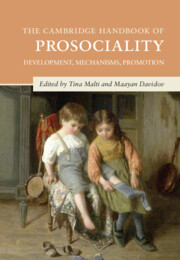Book contents
- The Cambridge Handbook of Prosociality
- Cambridge Handbooks in Psychology
- The Cambridge Handbook of Prosociality
- Copyright page
- Dedication
- Contents
- Figures
- Contributors
- Part I Development of Prosociality
- Part II Antecedents and Mechanisms of Prosociality
- Part III Development of Prosociality in Context
- 18 Parenting and Children’s Prosociality
- 19 Sibling Influences on Prosociality
- 20 Prosocial Behavior, Peer Relationships, and Friendships
- 21 Children’s Intergroup Prosocial Behavior
- 22 Prosocial Behavior in School Contexts
- 23 Community and Neighborhood Influences on Prosociality in Children and Youth
- 24 Culture and Prosociality
- 25 Prosocial Media
- Part IV Applications
- Index
- References
21 - Children’s Intergroup Prosocial Behavior
The Role of Group Stereotypes
from Part III - Development of Prosociality in Context
Published online by Cambridge University Press: 25 May 2023
- The Cambridge Handbook of Prosociality
- Cambridge Handbooks in Psychology
- The Cambridge Handbook of Prosociality
- Copyright page
- Dedication
- Contents
- Figures
- Contributors
- Part I Development of Prosociality
- Part II Antecedents and Mechanisms of Prosociality
- Part III Development of Prosociality in Context
- 18 Parenting and Children’s Prosociality
- 19 Sibling Influences on Prosociality
- 20 Prosocial Behavior, Peer Relationships, and Friendships
- 21 Children’s Intergroup Prosocial Behavior
- 22 Prosocial Behavior in School Contexts
- 23 Community and Neighborhood Influences on Prosociality in Children and Youth
- 24 Culture and Prosociality
- 25 Prosocial Media
- Part IV Applications
- Index
- References
Summary
Children are prosocial from a young age onward, but their prosocial actions are not necessarily egalitarian. From around 4 years of age children tend to help and share more with in-group members compared with out-group members. However, a growing body of findings also suggest that sometimes children act more prosocially toward out-group members. How can we reconcile such seemingly contradicting behaviors? Here, the author describes how the salience of group stereotypes might shed light on these inconsistent findings. Specifically, different helping contexts can activate different group stereotypes. These different stereotypes could lead children to sometimes act more prosocially toward in-group peers, but sometimes show out-group bias in their helping or sharing behavior. Taking into account group stereotypes in children’s prosocial behavior will provide a deeper understanding of the underlying motivations that lead to selective prosociality in children and, in the long run, contribute to combating discrimination and prejudice early in life.
- Type
- Chapter
- Information
- The Cambridge Handbook of ProsocialityDevelopment, Mechanisms, Promotion, pp. 427 - 441Publisher: Cambridge University PressPrint publication year: 2023
References
- 1
- Cited by



